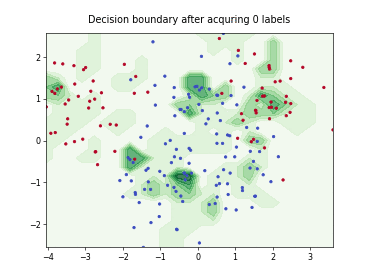skactiveml.pool.ProbCover#
- class skactiveml.pool.ProbCover(n_classes=None, deltas=None, alpha=0.95, cluster_algo=<class 'sklearn.cluster._kmeans.KMeans'>, cluster_algo_dict=None, n_cluster_param_name='n_clusters', distance_func=<function pairwise_distances>, missing_label=nan, random_state=None)[source]#
Bases:
SingleAnnotatorPoolQueryStrategyProbability Coverage
This class implements the Probability Coverage (ProbCover) query strategy [1], which aims at maximizing the probability coverage in a meaningful sample embedding space.
- Parameters
- n_classesNone or int, default=None
This parameter is used to determine the delta value. If n_classes=None, the number of classes is extracted from the given labels. If this extracted number of classes is below 2, n_classes=2 is used as a fallback.
- deltasNone or array-like of shape (n_deltas,), default=None
List of deltas (ball radii) to be tested for finding the maximum value satisfying a sample coverage >= alpha. If no value in deltas satisfies this constraint, a warning is raised where the minimum delta value is used. If deltas=None, the values np.arange(0.1, 2.1, 0.1) are used.
- alphafloat in (0, 1), alpha=0.95
Minimum coverage as a constraint for the delta selection.
- cluster_algoClusterMixin.__class__, default=sklearn.cluster.KMeans
The cluster algorithm to be used for determining the best delta value.
- cluster_algo_dictdict, default=None
The parameters passed to the clustering algorithm cluster_algo, excluding the parameter for the number of clusters.
- n_cluster_param_namestring, default=”n_clusters”
The name of the parameter for the number of clusters.
- distance_funccallable, default=sklearn.metrics.pairwise_distances
Takes as input X to compute the distances between each pair of samples. This function can also only return the precomputed distances of each pair in X for speedup.
- missing_labelscalar or string or np.nan or None, default=np.nan
Value to represent a missing label.
- random_stateNone or int or np.random.RandomState, default=None
The random state to use.
References
- 1
Yehuda, Ofer, Avihu Dekel, Guy Hacohen, and Daphna Weinshall. “Active Learning Through a Covering Lens.” NeurIPS, 2022.
Methods
Get metadata routing of this object.
get_params([deep])Get parameters for this estimator.
query(X, y[, candidates, batch_size, ...])Query the next samples to be labeled
set_params(**params)Set the parameters of this estimator.
- get_metadata_routing()#
Get metadata routing of this object.
Please check User Guide on how the routing mechanism works.
- Returns
- routingMetadataRequest
A
MetadataRequestencapsulating routing information.
- get_params(deep=True)#
Get parameters for this estimator.
- Parameters
- deepbool, default=True
If True, will return the parameters for this estimator and contained subobjects that are estimators.
- Returns
- paramsdict
Parameter names mapped to their values.
- query(X, y, candidates=None, batch_size=1, return_utilities=False, update=False)[source]#
Query the next samples to be labeled
- Parameters
- Xarray-like of shape (n_samples, n_features)
Training data set, usually complete, i.e. including the labeled and unlabeled samples.
- yarray-like of shape (n_samples,)
Labels of the training data set (possibly including unlabeled ones indicated by self.missing_label).
- candidatesNone or array-like of shape (n_candidates) with dtype=int, default=None
If candidates is None, the unlabeled samples from (X, y) are considered as candidates. If candidates is of shape (n_candidates,) and of type int, candidates is considered as a list of the indices of the samples in (X, y).
- batch_sizeint, default=1
The number of samples to be selected in one AL cycle.
- return_utilitiesbool, default=False
If True, also return the utilities based on the query strategy.
- updatebool, default=False
This boolean flag determines whether the computed delta_max_ and the distances_ shall be updated in the query. For the first call of query, this parameter has no impact because both quantities are computed for the first time.
- Returns
- query_indicesnumpy.ndarray of shape (batch_size,)
The query_indices indicate for which candidate sample a label is to be queried, e.g., query_indices[0] indicates the first selected sample. If candidates in None or of shape (n_candidates,), the indexing refers to samples in X.
- utilitiesnumpy.ndarray of shape (batch_size, n_samples)
The utilities of samples for selecting each sample of the batch. Here, utilities mean the out-degree of the candidate samples. If candidates is None or of shape (n_candidates,), the indexing refers to the samples in X.
- set_params(**params)#
Set the parameters of this estimator.
The method works on simple estimators as well as on nested objects (such as
Pipeline). The latter have parameters of the form<component>__<parameter>so that it’s possible to update each component of a nested object.- Parameters
- **paramsdict
Estimator parameters.
- Returns
- selfestimator instance
Estimator instance.
